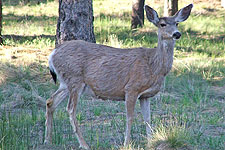Local Wildlife
Mule Deer

Scientific Name: Odocoileus hemionus
Addt'l Info: Univ. of Michigan
The mule deer gets its name from its large, mule-like ears. Its fur ranges in color from a dark, brownish gray to a light ash-gray to a reddish brown. The throat is white while the rump and underside of the tail may be white, cream, or a pale yellow. They can be seen all over the forested portions of Sunriver during the spring and fall. The large number of people in summer make them uncomfortable so they tend to stay in the Forest Service areas to the north, west, and east during this peak vacation period.
Mule deer primarily dine on highly digestible, succulent vegetation. They also eat acorns, legume seeds, and some fruits such as berries. In addition, they are capable of digesting woody and fibrous material such as twigs when more desirable food sources are in poor supply. This allows the mule deer to survive during the winter months when food sources are limited.
The courtship and mating of mule deer occur between individuals within their own group. The ability of a male to mate with a desirable female is, by and large, a function of size with the success rate higher for those with the largest bodies and antlers. The common litter size is two, with mothers in their first or second breeding year most frequently producing just a single baby.
Predators of the mule deer include pumas, coyotes, bobcats, golden eagles, feral dogs, and black bears. Mule deer specialize in detecting danger at a very long range by means of large ears and excellent vision. Males can quickly detect and visually track another animal as far as 600 meters.
